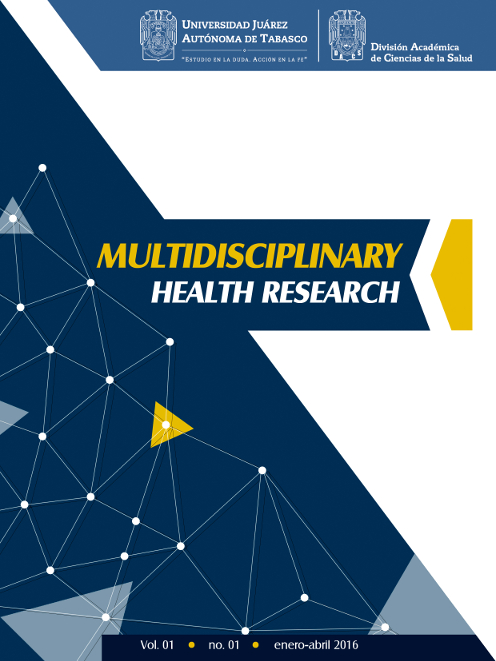Uso de la medicina alternativa y complementaria en pacientes con cáncer de mama que acuden a consulta en un hospital de alta especialidad en el estado de Tabasco
DOI:
https://doi.org/10.19136/mhr.a1n1.1339Resumen
Algunos pacientes consideran el uso de la medicina alternativa y complementaria (MAC) como una opción de tratamiento. Hasta el momento no se han reportado estudios que describan el uso de MAC en pacientes con cáncer en el estado de Tabasco. Este estudio tiene el objetivo de identificar el uso de medicina alternativa y complementaria en pacientes con cáncer de mama que acuden a un Hospital regional de alta especialidad. Método: Estudio descriptivo transversal. La muestra estuvo conformada por 105 pacientes con diagnóstico de cáncer de mama, que acuden a la consulta externa de oncología de un Hospital de Alta Especialidad en Tabasco, México. La recolección de datos se hizo a través de un cuestionario validado, de uso de MAC (Ezeome y Anarado, 2007) Resultados: El uso de MAC predominó en el 94% de la población, siendo los más comunes los productos biológicos (42%), donde se considera las plantas medicinales. Seguido de una dieta especial o régimen alimentario (33%). El 81.3% describió que usaban la MAC al mismo tiempo que el tratamiento convencional para que ambos actuaran mejor, según su percepción. El 68.8% esperaba que, con el uso de la MAC, se curara o tratara directamente el cáncer. Sin embargo, el 45% de los pacientes describió que solo percibió una mejora de su bienestar físico como uno de los beneficios obtenidos con el uso de éstas. Conclusión: El uso MAC es común en los pacientes con cáncer de mama. Es importante que el clínico pregunte acerca del uso de MAC, para llevar mejor control del paciente.
Abstract
Some patients consider necessary the use of alternative and complementary medicine (ACM) as a treatment option for their illnesses. There are not prior reports describing the use of ASM in patients with cancer in the estate of Tabasco. The objective of this study was to identify the use of alternative and supplementary medicine in patients with breast cancer that attend a regional specialty hospital. Methods: Cross-sectional descriptive study. The sample consisted of 105 patients with breast cancer diagnosis who attended oncology outpatient consultation sessions in a specialty hospital in Tabasco, Mexico. Data was collected using a validated ASM use questionnaire (Ezeome & Anarado, 2007). Results: Use of ASM was reported in 94% of the sample, being biological products, which include medicinal plants, the most used (42%). Special diets were the second most reported option (33%). 81% of the sample reported using ASM along with conventional treatment to improve efficacy of both, according to their perspective. 66.8% of the participants expected that with the use of ASM they would heal or directly treat cancer. Nevertheless, 45% of the sample described only being benefited with physical wellbeing as a result. Conclusion: The use of ASM is frequent in patients with breast cancer. It is important that clinicians ask patients about their use of ASM for a better patient control.
Referencias
Barnes, P. M., Bloom, B., & Nahin, R. L. (2008). Complementary and alternative medicine use among adults and children: United States, 2007.
Ezeome, E. R., & Anarado, A. N. (2007). Use of complementary and alternative medicine by cancer patients at the University of Nigeria Teaching Hospital, Enugu, Nigeria. BMC Complementary and Alternative Medicine, 7(1), 28.
McLay, J. S., Stewart, D., George, J., Rore, C., & Heys, S. D. (2012). Complementary and alternative medicines use by Scottish women with breast cancer. What, why and the potential for drug interactions? European journal of clinical pharmacology, 68(5), 811-819.
National Center for Complementary and Alternative Medicine. (2015). What is complementary and alternative medicine (CAM)? Recuperado de http://nccam.nih.gov/health/whatiscam/
National Cancer Institute. (2015). Complementary and alternative medicine. Recuperado de http://www.cancer.gov/about-cancer/treatment/cam
Nazik, E., Nazik, H., Api, M., Kale, A., & Aksu, M. (2012). Complementary and alternative medicine use by gynecologic oncology patients in Turkey. Asian Pacific Journal of Cancer Prevention, 13(1), 21-25.
Saghatchian, M., Bihan, C., Chenailler, C., Mazouni, C., Dauchy, S., & Delaloge, S. (2014). Exploring frontiers: Use of complementary and alternative medicine among patients with early-stage breast cancer. The Breast, 23(3), 279-285.
Sewitch, M. J., Yaffe, M., Maisonneuve, J., Prchal, J., &Ciampi, A. (2011). Use of complementary and alternative medicine by cancer patients at a Montreal hospital. Integrative cancer therapies, 10(4), 305-311.
Treister-Goltzman, Y., &Peleg, R. (2015). Trends in publications on complementary and alternative medicine in the medical literature. Journal of Complementary and Integrative Medicine, 12(2), 111-115.
Wanchai, A., Armer, J. M., & Stewart, B. R. (2010). Complementary and alternative medicine use among women with breast cancer: a systematic review. Clin J OncolNurs, 14(4), E45-E55.
Wang, H. H., & Chung, U. L. (2012). Use of complementary and alternative medicine among breast cancer survivors in Taiwan. Asian Pacific Journal of Cancer Prevention, 13(9), 4789-4792.


